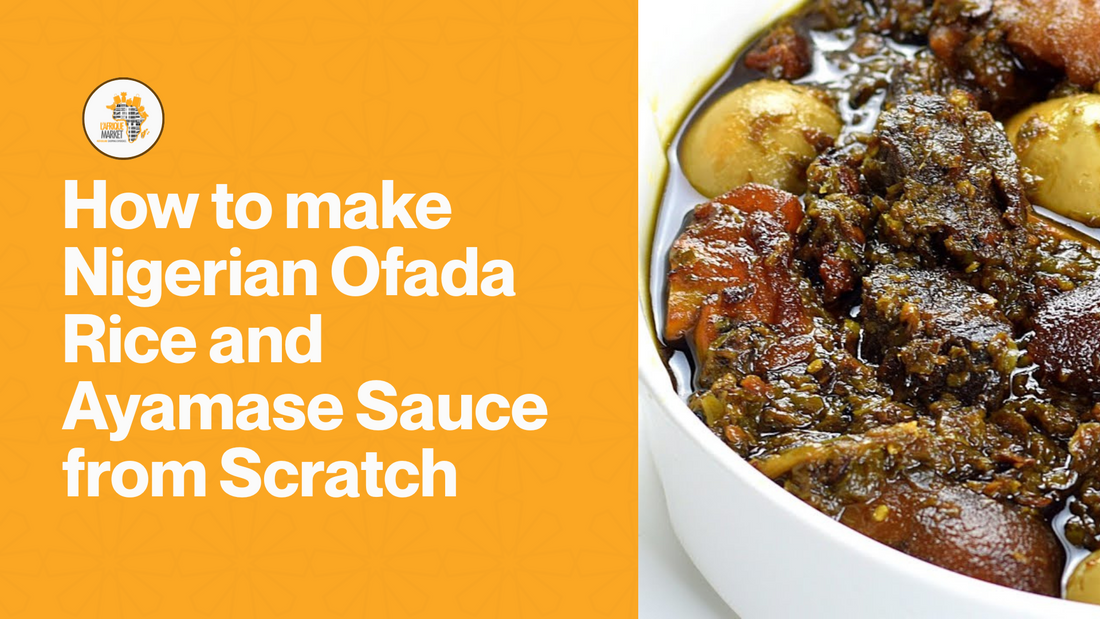
How to make Nigerian Ofada Rice and Ayamase Sauce from Scratch
Share
If you’re craving the authentic taste of Nigerian home cooking, few dishes deliver like Ofada rice with its iconic green Ayamase (Designer Stew) sauce. This duo is a staple at Yoruba celebrations and “buka” joints, beloved for its bold flavor, aromatic palm oil, and generous helpings of assorted meats. Here’s a rich, step-by-step guide to making Ofada rice and Ayamase sauce from scratch—no shortcuts, just pure, memorable flavor.

Image from: Chef Lola's Kitchen
What Is Ofada Rice?
Ofada rice is a locally grown, short-grain, unpolished Nigerian rice. It’s celebrated for its distinctive aroma, nutty taste, and slightly chewy texture. Unlike regular white rice, it often contains stones or husks and requires extra rinsing—but its rustic character is worth the effort.

Image from: Udy Foods
Ingredients for Ofada Rice
- 3 cups Ofada rice
- Water, enough to cook
- Salt, to taste
Cooking Ofada Rice
- Pick and Wash: Thoroughly sort through the rice to remove stones and husks. Wash several times until water runs clear.
- Parboil: Pour rice and enough water into a pot. Boil for 5–7 minutes, then drain and rinse to remove excess starch and any remaining husk.
- Cook: Return the rice to the pot, add clean water (just enough to cover), and salt to taste. Cook on medium heat until tender and the water is absorbed.
- Fluff and Serve: Fluff with a fork and cover with banana or “uma” leaves for extra aroma, if desired.
 Image from: Afropots
Image from: Afropots
Ayamase Sauce (Ofada Stew) From Scratch
Essential Ingredients
- 4–5 large green bell peppers (or green “tatashe” if available)
- 2–3 green scotch bonnet peppers (ata rodo) or to taste
- 1–2 green chilies (optional, for extra spice)
- 1–2 large onions (1 for blending, 1 chopped)
- ½ cup–1 cup palm oil (red oil)
- 2 tablespoons locust beans (iru)
- 2 tablespoons ground crayfish
- Beef stock or water (as needed)
- 1½–2 pounds assorted meats (beef, tripe/shaki, cow skin/pomo, goat meat, liver, etc.), pre-boiled
- 4–6 hard-boiled eggs, peeled
- 2–3 bouillon/seasoning cubes
- Salt to taste
Optional:
- Smoked or dried fish (for extra depth)
- Extra peppers for a hotter stew
Step-by-Step Directions
1. Prep the Peppers and Onions
- Rinse and deseed the bell peppers. Combine with scotch bonnet and green chilies. Chop roughly for easier blending.
- Peel one onion and include it for blending.

Image from: BBC Good Food
Pro Tip: Roasting peppers and onion in the oven (400–425°F for 15–20 min) intensifies the flavor.
2. Blend and Cook Pepper Mix
- Blend peppers and onion in a food processor to a coarse consistency—don’t make it too smooth!
- Pour into a pot and boil on medium-high heat until most moisture evaporates and mix thickens.

Image from: Gifted Culinarian
3. “Bleach” the Palm Oil
- Pour palm oil into a clean, dry pot. Heat over medium-low with cover on (to avoid splattering and smoke). Let it change color from red to light golden or clear (about 8–12 minutes).
- Cool slightly (oil will be very hot!), then add the chopped onion, locust beans, and half the crayfish. Sauté until onions are soft and aromatic.

Image from: Cookpad.com
Note: Never stand directly over the hot oil; use a vent hood if possible.
4. Build Your Sauce
- Add the thickened pepper blend to the pot. Cook and stir over medium heat until the oil floats on top and the sauce darkens (about 10–15 minutes).
- Stir in remaining crayfish, beef stock, bouillon cubes, and salt. Add boiled assorted meats, pomo, and fish (if using).
- Add peeled boiled eggs—this is classic!
- Simmer on low heat so the meats and eggs soak up the sauce. Taste and adjust salt, crayfish, or pepper as needed.
5. Final Simmer & Serve
- Allow sauce to simmer uncovered for 5–10 more minutes, stirring occasionally until thick, rich, and glossy.
- Serve Ayamase sauce hot over a mound of Ofada rice, ideally lined with banana leaves for true authenticity.

Image from: Sisi Jemimah's Recipes
Shop pre-mixed ayamase pepper to make the perfect pot of stew on L'Afrique Market.
Pro Tips
- Stone-pick and rinse Ofada rice carefully: Its unpolished nature means extra debris.
- Palm oil “bleaching” must be carefully monitored: Ventilation helps reduce strong aromas and smoke.
- Umami depth: Locust beans and crayfish are essential for the sauce’s signature aroma; don’t skip them!
- Protein matters: Use a mix of meats—shaki, pomo, and beef—for the best texture and richness.
Why Ofada Rice and Ayamase Are Special
This beloved combo is more than a meal—it’s a celebration of local ingredients, tradition, and community. The nutty, chewy rice and deeply savory, spicy stew create an explosion of flavors cherished by Nigerians everywhere.
